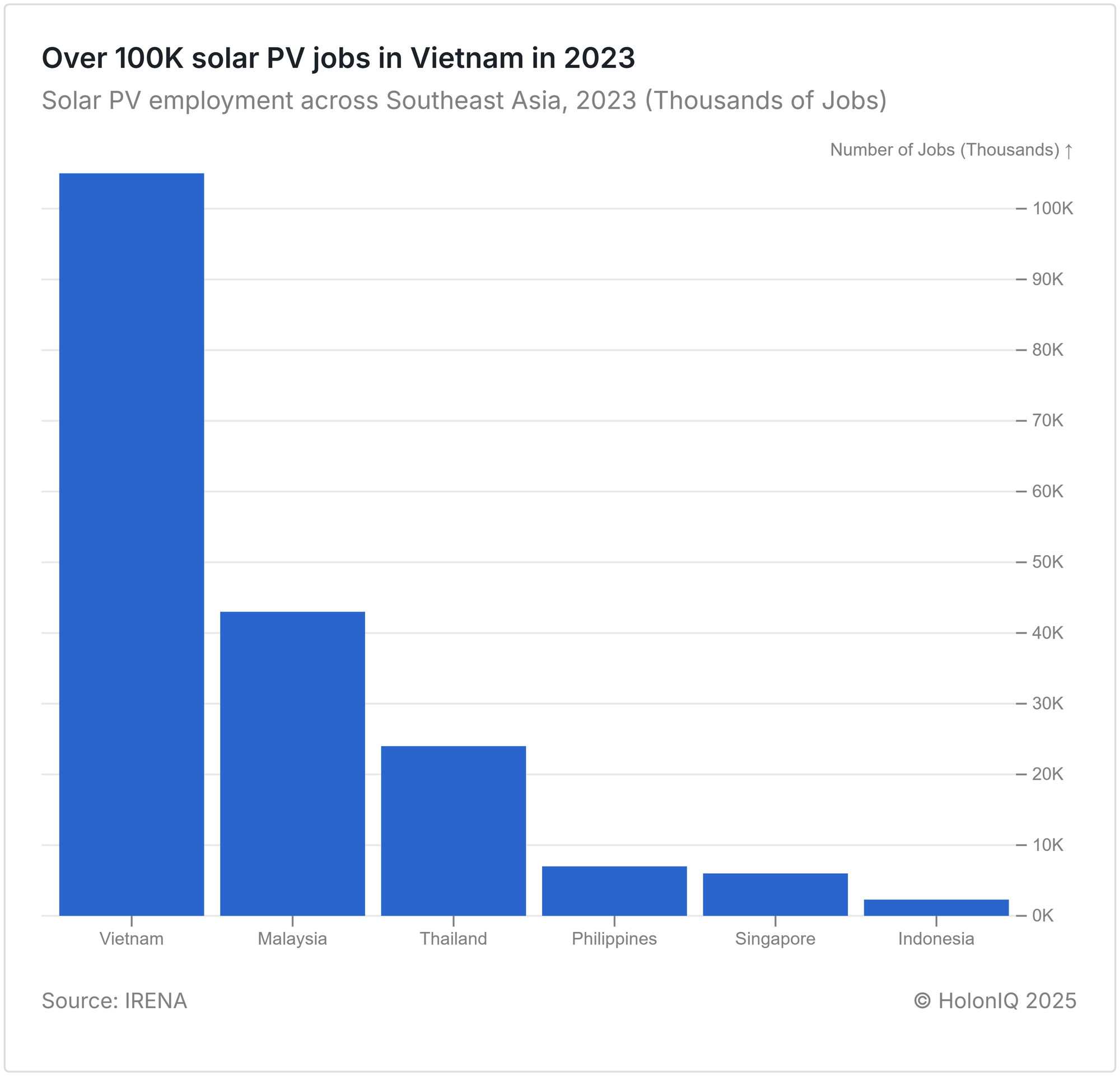🌎 Green Skills #20
HolonIQ is tracking reskilling and upskilling efforts as technology, decarbonization, and global dynamics reshape energy, environment, infrastructure, and mobility sectors. Targeted workforce development is key to enhancing skills, driving growth, and supporting sustainable progress.

Southeast Asia is witnessing a surge in green energy investments, led by a $10B initiative between Indonesia and Singapore to advance solar manufacturing, carbon capture, and green industrial zones—creating thousands of jobs and strengthening the region’s green economy. This momentum is echoed in the region’s solar sector, where job growth is accelerating, though unevenly—Vietnam and Malaysia are emerging as key leaders in solar employment, reflecting broader regional shifts toward clean energy leadership. Meanwhile, Germany committed $50M to boost Vietnam’s green workforce through enhanced vocational training in renewables. In the US, rising AI-driven energy demands are prompting a resurgence of nuclear energy, with plans for 10 new reactors by 2030. Debates on clean energy incentives and permitting reforms signal major policy shifts ahead.
Thanks for reading!
Not a subscriber yet?
Green Labor Market Trends
🌱 Indonesia & Singapore’s $10B Green Energy Boost Creates Jobs. The $10B investment will create thousands of jobs in solar manufacturing, carbon capture, and green zones. It aims to build a skilled workforce and enhance the region’s leadership in the green economy.
🤖 Petronas Launches Energy Transition Academy as It Restructures Workforce. While planning 10% global layoffs to pivot toward low-carbon energy, the Malaysian oil giant unveils P-ETA to upskill workers in renewables, hydrogen, and carbon management. The initiative aims to support an equitable energy future and create long-term green jobs.
🌬️ UK Wind Jobs Hit 55,000, Set to Double by 2030. Offshore wind drives growth as industry targets 112,000 roles, calling for fast-track training to fill key skill gaps.
Solar Jobs are Booming Unevenly Across Southeast Asia Led by Vietnam and Malaysia

🔋 Vietnam Powers Ahead with 105,000 Solar Jobs, showcasing the impact of large-scale solar deployment and domestic manufacturing leadership.
🏭 Malaysia builds a Strong Solar Base with 43,000 Jobs, though it faces restructuring pressure as energy majors pivot to renewables.
🌱 Indonesia Struggles to Scale with Only 2,300 Jobs, despite a $10B green investment plan targeting solar, carbon capture, and green zones.
🧠 Singapore Positions for High-Tech Growth with 6,000 Solar Roles, leveraging policy, innovation, and regional leadership to boost clean energy talent.
🎯 Actionable Strategies: To unlock Southeast Asia’s solar workforce potential, countries must pair investment with inclusive training systems. Indonesia and Singapore’s $10B push can be a model, if backed by scalable vocational programs, local supply chain incentives, and regional certification standards. Malaysia’s P-ETA shows how legacy energy workers can transition to renewables. A connected, skilled, and mobile solar workforce will be critical to realizing the region’s green economy ambitions.
Upskilling/Reskilling Intiatives
🧑🏭 Germany Invests $50M to Power Vietnam’s Green Workforce. The GIZ-led initiative enhances vocational training in renewables, equipping workers with the critical skills necessary for the country’s energy transition.
⚡ Centre & Shell India Partner to Skill Youth in EV & Green Energy. A national skilling program was launched to train 5,000+ youth in EV, solar, and green jobs across India, with Shell India and NSDC collaboration. The initiative includes classroom and hands-on training, aiming to build a future-ready workforce for India’s clean energy transition.
🤖 UK Tackles Green Skills Shortage by Combining Robotics with Human Expertise in Advanced Welding. The University of Nottingham develops a robotic system that learns from human welders by capturing key techniques and storing them in a digital skills library. The system addresses complex welds, alleviating labor shortages and enhancing productivity across the aerospace, construction, and maritime sectors.
Policy Initiatives
🪫 US Taps Nuclear in AI Era as Energy Policy Shifts. With AI fueling soaring energy demand, plans for 10 new reactors by 2030 gain momentum. Lawmakers debate clean energy incentives, faster permitting, and tech exports as nuclear emerges as a core solution.
👷 UK Renewable Sector Drives Workforce Policy to Boost Skills and Diversity. Industry leaders are pushing for training and talent pipelines to support the growth of offshore wind and local communities.
Like getting this newsletter? Request a demo for unlimited access to over one million charts
Thank you for reading. Have a great week ahead!
Have some feedback or suggestions? Let us know at hello@holoniq.com




